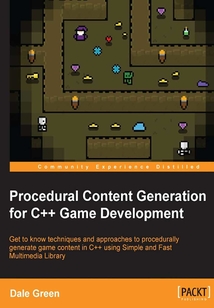首頁(yè) > 計(jì)算機(jī)網(wǎng)絡(luò) >
編程語(yǔ)言與程序設(shè)計(jì)
> Procedural Content Generation for C++ Game Development最新章節(jié)目錄
舉報(bào) 

會(huì)員
Procedural Content Generation for C++ Game Development
最新章節(jié):
Index
Proceduralgenerationisagrowingtrendingamedevelopment.Itallowsdeveloperstocreategamesthatarebiggerandmoredynamic,givingthegamesahigherlevelofreplayability.Proceduralgenerationisn’tjustonetechnique,it’sacollectionoftechniquesandapproachesthatareusedtogethertocreatedynamicsystemsandobjects.C++istheindustry-standardprogramminglanguagetowritecomputergames.It’sattheheartofmostengines,andisincrediblypowerful.SFMLisaneasy-to-use,cross-platform,andopen-sourcemultimedialibrary.Accesstocomputerhardwareisbrokenintosuccinctmodules,makingitagreatchoiceifyouwanttodevelopcross-platformgameswithease.UsingC++andSFMLtechnologies,thisbookwillguideyouthroughthetechniquesandapproachesusedtogeneratecontentprocedurallywithingamedevelopment.Throughoutthecourseofthisbook,we’lllookatexamplesofthesetechnologies,startingwithsettinguparoguelikeprojectusingtheC++template.We’llthenmoveontousingRNGwithC++datatypesandrandomlyscatteringobjectswithinagamemap.Wewillcreatesimpleconsoleexamplestoimplementinarealgamebycreatinguniqueandrandomisedgameitems,dynamicsprites,andeffects,andprocedurallygeneratinggameevents.Thenwewillwalkyouthroughgeneratingrandomgamemaps.Attheend,wewillhavearetrospectivelookattheproject.Bytheendofthebook,notonlywillyouhaveasolidunderstandingofproceduralgeneration,butyou’llalsohaveaworkingroguelikegamethatyouwillhaveextendedusingtheexamplesprovided.
目錄(120章)
倒序
- 封面
- 版權(quán)頁(yè)
- Credits
- About the Author
- Acknowledgment
- About the Reviewer
- www.PacktPub.com
- Support files eBooks discount offers and more
- Preface
- What this book covers
- What you need for this book
- Who this book is for
- Conventions
- Reader feedback
- Customer support
- Chapter 1. An Introduction to Procedural Generation
- Procedural generation versus random generation
- Introducing randomness
- Seeds
- The use of procedural generation in games
- Texture creation
- Benefits of procedural generation
- The drawbacks of procedural generation
- A brief history of rogue-like games
- How we'll implement procedural generation
- Creating unique art
- Audio manipulation
- Component-based design
- The complete game
- Exercises
- Summary
- Chapter 2. Project Setup and Breakdown
- Choosing an IDE
- Breaking down the game template
- Simple and Fast Multimedia Library (SFML)
- Polymorphism
- The roguelike template setup
- Exercises
- Summary
- Chapter 3. Using RNG with C++ Data Types
- Setting the game seed
- Setting Boolean values randomly
- Random number distribution
- Giving the player random stats
- Accessing random elements of a collection
- Spawning a random item
- Generating random characters
- Repeating loops
- Spawning a random number of items
- Exercises
- Summary
- Chapter 4. Procedurally Populating Game Environments
- Potential obstacles
- Level tiles
- Defining the spawn area
- Selecting a suitable game tile
- Spawning items at a random location
- Spawning random tiles
- Exercises
- Summary
- Chapter 5. Creating Unique and Randomized Game Objects
- Creating a random player character
- Procedurally generating an enemy class
- Procedural items
- The random potion class
- Exercises
- Summary
- Chapter 6. Procedurally Generating Art
- How procedural generation is used with art
- The benefits of procedurally generated art
- The drawbacks of procedurally generated art
- Using SFML sprite modifiers
- Saving modified sprites
- Creating enemy sprites procedurally
- Editing the game tiles
- Exercises
- Summary
- Chapter 7. Procedurally Modifying Audio
- An introduction to SFML audio
- Selecting a random main track
- Adding sound effects
- Editing sound effects
- Playing a sound function
- 3D sound – spatialization
- Exercises
- Summary
- Chapter 8. Procedural Behavior and Mechanics
- An introduction to pathfinding
- A breakdown of A*
- Coding the A* pathfinding algorithm
- Implementing A* in the game
- Procedurally generated level goals
- Exercises
- Summary
- Chapter 9. Procedural Dungeon Generation
- The benefits of procedural level design
- Considerations
- An overview of dungeon generation overview
- The recursive backtracker
- Procedurally generating a dungeon
- Choosing the tile textures
- Exercises
- Summary
- Chapter 10. Component-Based Architecture
- Understanding component-based architecture
- Designing the component system
- C++ templates
- Function overloading
- Creating a base component
- Component functions
- Creating a transform component
- Creating a SpriteComponent
- Creating an audio component
- Exercises
- Summary
- Chapter 11. Epilogue
- Project breakdown
- The pros and cons of procedural generation
- Summary
- Index 更新時(shí)間:2021-07-16 09:38:07
推薦閱讀
- Cocos2D-X權(quán)威指南(第2版)
- 企業(yè)級(jí)Java EE架構(gòu)設(shè)計(jì)精深實(shí)踐
- 小創(chuàng)客玩轉(zhuǎn)圖形化編程
- 自己動(dòng)手寫Java虛擬機(jī)
- R語(yǔ)言數(shù)據(jù)可視化實(shí)戰(zhàn)
- 單片機(jī)應(yīng)用與調(diào)試項(xiàng)目教程(C語(yǔ)言版)
- 前端HTML+CSS修煉之道(視頻同步+直播)
- Java網(wǎng)絡(luò)編程實(shí)戰(zhàn)
- ServiceNow:Building Powerful Workflows
- Java SE實(shí)踐教程
- ScratchJr趣味編程動(dòng)手玩:讓孩子用編程講故事
- Distributed Computing in Java 9
- C語(yǔ)言從入門到精通
- Pandas 1.x Cookbook
- 生成藝術(shù):Processing視覺創(chuàng)意入門
- 前端程序員面試筆試真題與解析
- Instant PhoneGap
- 大數(shù)據(jù)高并發(fā)Redis一本通
- Go底層原理與工程化實(shí)踐
- 分布式中間件技術(shù)實(shí)戰(zhàn):Java版
- Visual C++程序開發(fā)參考手冊(cè)
- The Data Science Workshop
- Python全案例學(xué)習(xí)與實(shí)踐
- 3D Game Design with Unreal Engine 4 and Blender
- Node.js Design Patterns(Second Edition)
- Python數(shù)據(jù)分析、挖掘與可視化(慕課版)
- INSTANT Citrix XenApp
- 明解C++
- Tkinter GUI Application Development Cookbook
- FPGA Verilog開發(fā)實(shí)戰(zhàn)指南:基于Intel Cyclone IV(基礎(chǔ)篇)

